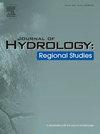Enhancing multi-temporal drought forecasting accuracy for Iran: Integrating an innovative hidden pattern identifier, recursive feature elimination, and explainable ensemble learning
IF 4.7
2区 地球科学
Q1 WATER RESOURCES
引用次数: 0
Abstract
Study region
The Bam and Babolar stations are located in hyperarid and humid climates in Iran, respectively.
Study focus
The primary objective of this study is to implement Artificial Intelligence (AI) to enhance multistep forecasting of the Standardized Precipitation Evapotranspiration Index (SPEI) for time horizons of one, six, and twelve months. The research employs an innovative hybrid approach that integrates a novel decomposition technique known as Hidden Pattern Feature Extraction Statistical Mode Decomposition (HPFE-SMD), along with Recursive Feature Elimination (RFE) for feature selection, and the Extra Tree Regressor (ETR) model. Additionally, the effectiveness of the suggested model (HPFE-ETR) was assessed and contrasted with two common methods, Time-Varying Filter-based Empirical Mode Decomposition (TVF-EMD) and Variational Mode Decomposition (VMD), both of which were combined with ETR.
New hydrological insights for the region
The results showed that the HPFE-ETR model consistently outperformed comparative models, and it significantly improved drought forecasting accuracy, with the largest improvements for SPEI 12 (t + 12) and more moderate gains for SPEI 12 (t + 1). In particular, the model reduced forecasting errors for SPEI 12 by about 70 % in humid climates and 43 % in hyperarid climates, demonstrating its adaptability across different climatic conditions at both study stations. Explainability results revealed that mean features had the strongest positive influence on SPEI 12 forecasts, underscoring the model’s robustness in capturing key drought drivers. These findings highlight the HPFE-ETR model’s potential to revolutionize drought early warning systems and water resource management strategies.
求助全文
约1分钟内获得全文
求助全文
来源期刊

Journal of Hydrology-Regional Studies
Earth and Planetary Sciences-Earth and Planetary Sciences (miscellaneous)
CiteScore
6.70
自引率
8.50%
发文量
284
审稿时长
60 days
期刊介绍:
Journal of Hydrology: Regional Studies publishes original research papers enhancing the science of hydrology and aiming at region-specific problems, past and future conditions, analysis, review and solutions. The journal particularly welcomes research papers that deliver new insights into region-specific hydrological processes and responses to changing conditions, as well as contributions that incorporate interdisciplinarity and translational science.
 求助内容:
求助内容: 应助结果提醒方式:
应助结果提醒方式:


